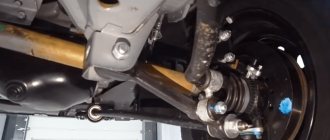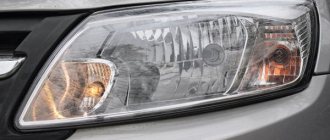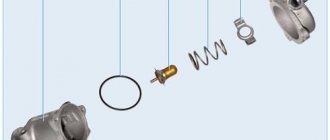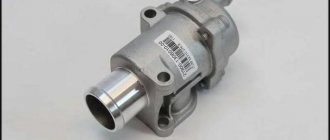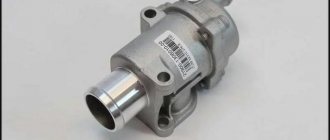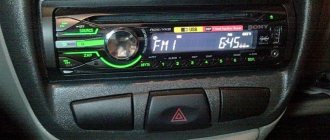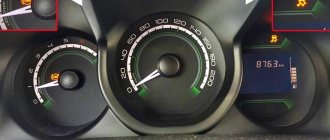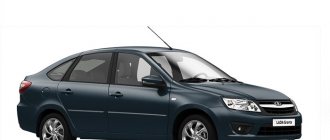Acoustics for the front doors of Lada Granta
Installing speakers in Granta doors allows you to be independent of the body type - speakers in the doors do not require an acoustic shelf. This means that you can install speakers in a sedan and a hatchback according to the same principle.
Preparatory work
Before we begin the installation itself, let's figure out how to prepare the car. For this:
- We disassemble the door: dismantle the handle (pry up and remove the trim, unscrew 2 screws), the tip of the limit switch, two screws from the bottom of the door, overcoming the resistance of the retaining pins, pull the door card toward you and remove it from the door;
- We soundproof the door: in the warm season or in a heated garage, we cover all accessible parts of the door with vibroplast. Vibroplast StP M2 is suitable; when applying it to the door, be sure to heat it with a construction hairdryer and roll it with a pressure roller;
- If you have Spleen thermal insulation material, we cover the inside of the door card with it. This will further hide noise from the door when assembled;
- We are preparing spacers, if any are required for installing 16 cm speakers - more about them later in the text;
- We replace the factory terminals on the speaker wire in the door with normal ones (usually good terminals are included with the speakers) - to do this, we simply cut off the unnecessary connectors and attach the terminals we need to the wiring. A high-quality twist with heat shrink is sufficient;
- If the door panels do not have holes for speakers, we prepare them. It would be optimal to supply factory acoustic grids, which are installed on luxury versions of Granta and Datsun OnDo.
Installing speakers in Granta front doors
The standard acoustics in Grant are 13 cm speakers. They do not produce good sound, but they are easily installed in the factory holes for the speakers without unnecessary manipulation. The procedure for dealing with them is simple:
- connect the speaker cables, observing the polarity;
- fix with screws in regular places in the metal of the door or directly on the door card;
- install grids (in common parlance - grills).
An important disadvantage is that the center of the mounting hole and the place under the grill do not coincide. This means that when installed with complete grills, they will look asymmetrical and clumsy.
Standard acoustics most often do not produce a rich sound and, when installed with their own grids, look poor.
How to install 16cm speakers with spacers
In pursuit of sound, it is logical to install 16 cm speakers. This is where all the disadvantages of the AvtoVAZ design appear - the speakers either are not centered, or do not allow the window to roll down, or interfere with the glove compartment lid.
Why are spacers needed? In order not to cut the door, if you do not put the acoustics in the spacer rings, you will have to attach it to the metal of the door. This may result in the need to cut the door itself in order for the speaker to fit in, and is dangerous for the glass.
For this reason, speaker rings made of plywood are attached to the metal of the door, and the speaker itself is attached to them.
The procedure is as follows:
- we make or buy spacers for speakers - thickness 10 mm, material plywood;
- cut a hole for the speaker in the card and mark the installation location along it;
- put the spacer on 4 self-tapping screws;
- We install a column in it - observe the polarity!;
- install the map + install the standard mesh so that it doesn’t interfere with the glove compartment.
If the spacer bursts during installation, this may result in a rattling noise coming from the door while driving.
What speakers are better to put in the front doors instead of standard speakers?
We recommend the Pioneer TS-G1733I model. At a price of about 2 thousand rubles, they are freely installed through spacers in Granta doors without cutting metal and do not interfere with the glass. Easy installation will save you nerves and time.
Description of the ISOFIX fastening system
Have you ever installed a child seat in your car? And if this is so, then many have problems with this - either the fastening belt has fallen into the wrong groove, or it has become twisted or loosely tensioned, and can no longer perform its intended function of protecting against emergency situations.
All these standard situations can be avoided if you use an improved method of attaching child car seats in your car using the ISOFIX system.
The seat will not tilt, move or come unfastened, since the design is very rigid and reliable, supplied in most brands of cars from leading European brands. And the design itself is an international standard for fastening seats for small passengers.
The principle of fastening is simple - on seats with the ISOFIX system installed, there are two small brackets located at the base, they allow reliable coupling with the main rear seat - they are simply snapped to the safety brackets, and the installation is ready.
Advantages and disadvantages
The advantages of the system include:
- Quick and easy installation of the seat in the car. This will take less than a minute.
- Incorrect fixation of the car seat is virtually eliminated. A chair with the Isofix system cannot be installed incorrectly; in addition, the brackets make a certain click when closing.
- A chair with such a fastening system will reliably protect the baby in the event of an accident or impact. Crash tests have proven that this system is the most reliable and safe.
- The rigid coupling does not allow the chair to move in different directions. In the event of a side impact, it will not budge and will take most of the load on itself.
- The mounts are connected to the car body, not to the seats.
Among the disadvantages are:
- To install an Isofix seat, you need to have the necessary fasteners in your car.
- Just like an additional option in a car, the chair itself may be more expensive compared to other models.
- The Isofix car seat takes up enough space in the cabin and is slightly heavier than its counterparts.
- The system works correctly only when the child weighs up to 16-18 kilograms. Fastenings exceeding the established standards may not withstand the load. If the weight is greater, additional fixation is needed.
TABLE OF EXPERT ASSESSMENTS
The table opens in full size with a mouse click.
- Description
- Reviews (0)
- Question answer
Covering the child seat mount for the Lada Granta car
New items
Original standard lower rear bumper trim with holes for parking sensors for Lada Vesta sedan. ..
Original central dashboard trim for Lada Xray in gloss black with XRAY logo. ..
Front long mudguards for Lada Granta, Kalina-2 and Datsun. The length of the free edge of the mudguard is 9cm, these mudguards are the...
Carpet covers for the central floor tunnel of Lada Largus are designed to protect the car interior from dust and dirt. After installation ..
Front carpet covers for Lada Largus are designed to protect the car interior from dust and dirt. After installing the products on the car...
Features of application
p, blockquote 25,0,0,0,0 —>
Isofix is used in child car seat groups 0+, 1 and 2/3. When transporting children weighing from 15 to 36 kg, such a fastening is an auxiliary device. The main load should be provided by the car's standard seat belts.
p, blockquote 26,0,0,0,0 —>
p, blockquote 27,1,0,0,0 —>
There are no seat belts in car seats of these groups. The child is fastened with the car's standard seat belt system.
p, blockquote 28,0,0,0,0 —>
p, blockquote 29,0,0,0,0 —>
It would seem, why then use Isofix mounts in this group of car seats? The fact is that in case of a side impact, it significantly reduces the lateral displacement of the child. In the event of a frontal collision, the child car seat moves along the Isofix mounting slide, accompanying the child until the standard seat belts begin to operate, providing “all-round protection” for the child.
p, blockquote 30,0,0,0,0 —>
In group 0+, Isofix is a two-component system consisting of a base on which the main fastening elements and a carrying cradle are located. These two components can be purchased separately if the design elements are standardized. In some models, when a child moves from one weight category to another, you do not need to change the basic system (for example, Maxi-Cosi).
p, blockquote 31,0,0,0,0 —>
p, blockquote 32,0,0,0,0 —>
The base can be made in various versions.
p, blockquote 33,0,0,0,0 —>
p, blockquote 34,0,0,0,0 —>
This is very convenient for parents of babies. The cradle is usually small in size and weight. In it, you can bring him into the car without waking up the child and, accordingly, take him out of it, without making complex fastenings.
p, blockquote 35,0,0,0,0 —>
A special feature of the design of groups 0 and 1 is that Isofix has built-in seat belts. Securing with standard car seat belts is not required. This places 100% responsibility on the Isofix design and, above all, on:
p, blockquote 36,0,0,0,0 —>
- mechanical fastening to standard car brackets;
- base-cradle mounting design;
- reliability of built-in seat belts;
- strength of the stop.
Therefore, you should purchase a child car seat only from verified official ones; a car seat can reduce the degree of protection of the child to zero.
p, blockquote 37,0,0,0,0 —>
In children's systems 0+/1, a more convenient rotating bowl is sometimes used, since older children prefer the forward location of the examination area, while the reverse location for caring for the child is more convenient for parents.
p, blockquote 38,0,0,0,0 —>
The presence of a 3rd support point is mandatory for group 1 according to ECE R44/04 regulations, since during a frontal impact enormous forces are applied to the car seat. Some designs, such as the Romer Versafix, do not have additional support.
p, blockquote 39,0,0,0,0 —>
This is compensated by a special movable structure that redirects the impact force downward, that is, to the standard structure of the car seat. But such a child car seat cannot be installed on all cars equipped with the Isofix system.
p, blockquote 40,0,0,1,0 —> adsp-pro-2 —>
It is necessary to read the instructions supplied with the Romer Versafix, which contains a list of compatible car models. In general, you should carefully consider the purchase of a child car seat and its compatibility with the design of the car, since the question is about the safety of your child.
p, blockquote 41,0,0,0,0 —>
Other analogues
p, blockquote 42,0,0,0,0 —>
The American analogue of Isofix is the LATCH system. The car has brackets for attaching car seats. The child seat has straps with carabiners that are attached to the brackets.
p, blockquote 43,0,0,0,0 —>
p, blockquote 44,0,0,0,0 —>
Thus, the main difference between the LATCH system is the movable belt connection with the child car seat. A higher degree of mobility during a collision increases the likelihood of a child's lateral movements and, accordingly, injury.
p, blockquote 45,0,0,0,0 —>
In practice, it is more convenient during installation and removal; in case of small impacts, due to its mobility, it compensates for the accelerating load.
p, blockquote 46,0,0,0,0 —>
In Canada, the UAS (Universal Anchorage System) standard is used, otherwise Canfix. It is also compatible with the Isofix system, but has a greater degree of movement than the European one.
p, blockquote 47,0,0,0,0 —>
IN PLACES
15th place “Mazda BT-50”
The pickup truck turned out to be the most unsuitable for transporting children, which, however, was expected. Due to the high seats, it is difficult to install the child seat either forward or backward. The door openings are narrow, especially the rear: only 450 mm. Moreover, this car is one of the most cramped in the editorial fleet. Even if a front passenger of average height moves close to the instrument panel, a child sitting in the rear in the direction of travel has only 230 mm of legroom left.
The cradle fits, but with difficulty. In addition, the belts are short, there are no Isofixes, and the airbag cannot be switched off.
14th place “Lada-Priora”
In the Priora, due to the short length of the belt, it is impossible to install a cradle on the front passenger seat. The passenger airbag does not turn off, but this cannot serve as an excuse, because AVTOVAZ produces modifications without it. There is enough space in the front. However, the seat does not move far, which makes it difficult to install the chair. It is difficult to fasten the cradle to the second row seat: the belt is stretched like a string. And the distance between the first and second rows is no greater than in a pickup truck.
The door that doesn't swing wide makes it difficult to get child seats into the back seat.
13th place “Lifan-Solano”
The “Chinese” also does not have enough belt length to install the cradle on the front seat. Well, we won’t, since there is no airbag switch here. True, the manufacturer forgot to put a warning sign about this. He didn’t bother with “isofixes” either. But installing child seats on the rear sofa of the Lifan is convenient: the doorways are large, the thresholds are narrow.
Only the modest distance between the front and rear seats spoiled the assessment.
12–10 place “Ford Focus”
The doorways are quite large. However, when installing the chair in the front seat, you come across a massive dashboard, and in the back you hit the sloping upper corner, like most sedans. The passenger airbag does not turn off.
In terms of the length of the front belt, the Focus is one of the record holders in our fleet; the rear belt has to be pulled out to the limit to secure the cradle. It is possible that more bulky seat models can only be fixed with Isofix.
12–10 place “Lada-Granta”
The new model is adapted for transporting children no worse than many foreign cars. The distance between the seats is tolerable, the door openings are wide. Except that you have to bend around the rear pillar when you put a child seat of the first group into the second row.
There are just enough straps - you can fasten the cradle from the front only with the seat pushed back all the way. But at the back, a pleasant surprise will be not only Isofix fastenings, but also additional “top tezer”.
12–10 place “Lancer”
Installing seats in a Mitsubishi is hampered by low doorways and wide sills. In front, a massive dashboard adds inconvenience, taking up precious millimeters of space. However, judging by the absence of a passenger airbag switch, the manufacturer is against transporting children next to the driver. In addition, there is a convenient “Isofix” at the back - you get into the locks the first time.
There will be no problems with an alternative fastening with a belt either - the strap can be used to encircle any chair.
9–6 places “Polo Sedan”
The back seat of the Volkswagen is slightly shifted back relative to the opening - the child seat has to be carried in with outstretched arms, and here, in addition, the threshold is wide. The Isofix brackets are recessed quite deeply - you will suffer before you catch the locks on them.
It’s easier to place a seat in the first row, but, unfortunately, the front passenger airbag cannot be turned off. By the way, German-made hatchbacks have such a function, albeit in the list of additional options, but on the Russian sedan, apparently, they saved money.
FakeHeader
Comments 13
Hi all! Please advise! No matter how many times I try to secure the child seats with Isofix, it just doesn’t work. The seats themselves are in the way. There are plastic guides. If it doesn’t work out, I’ll cut off the interfering cover and adjust the seat grants, I’ll have to rip it where it’s in the way. The safety of children is billions of times more important than the upholstery of a chair. Maybe there is a way to install it in a more civilized way. I've tried it 3 times already, the seats get in the way and the cover gets in the way. I haven't installed everything yet. Who resolved the issue?
Avtozavodskoe highway, 3 "A"
Your questions: +73
Contact: [email protected]
How to use Isofix in a car
The isofix seat mounting system presents some complexity only at first acquaintance.
Before you begin installation, you need to find the mounting locations for the brackets. They can be located either completely openly or hidden behind plugs or decorative overlays with a symbolic image of a child seat.
Before installing the isofix mount, the plugs are removed. Then, pulling out the brackets with latches, insert them into the grooves. When doing this, be careful not to pinch the rear seat belt buckle or webbing.
Triggering is confirmed by a characteristic click, as well as a change in the color of the indicator curtain.
In most models of chairs, the brackets extend. This is done by rotating a special drum, moving the chair itself, pressing the corresponding lever, etc. Using the method specified in the instructions, move the chair towards the back of the seat until it stops. In this case, the latch buttons are blocked from accidental pressing. Chair installation is complete.
Features of fastening a chair up to 13 kg
The type of seats belonging to 0 or 0+ provide for placing the child in a removable cradle. To secure it in the rear seat, a separate base is provided.
The base has a folding support column, with which the isofix system fixes the seat in the rear seats at three points
The fixation of the latches on the brackets and the folding leg of the base, just as when attaching a regular chair, is confirmed by the appearance of a green curtain on the mechanism indicators.
The chair is placed on a fixed base. In this case, the child may already be in it. The latch is activated, after which the lever is turned, which also serves to carry the cradle. This will lock the latch, which will again be confirmed by the green indicator.
To remove the seat, you need to unfold the handle again, release the latch by pressing the special handle and remove the crib.
The video gives an idea of how to install the base:
Designs from 9 to 18 kg
This type of seat can be made with or without a base. In the second case, the anchor belt serves as an additional fixation of the chair. On one side it is attached to the back of the child seat, on the other it clings to a latch located at the headrest of the car seat, on its backrest, or in the luggage compartment of the car.
This video can tell you more about this:
https://youtube.com/watch?v=BTRXWxkVfVY
During sudden braking, including a head-on collision, the belt will prevent the seat from tipping over, even if the latches on the bottom cannot withstand the load.
Car seats from 9 to 36 kg
By law, the fastening of seats designed for such a child’s weight must be accompanied by additional fixation. As a rule, standard seat belts in the rear seat of the car are used for this.
It's easy to do. Once the isofix pins are engaged with the brackets, the chair is raised. The straps are wound behind the back, secured in locks and tightened, securely pressing the child seat to the seat.
Car seats from 15 to 36 kg
This type of seat belongs to the third load category. Along with the regular chairs, the installation of which we talked about above, this category includes the so-called “boosters”. This is a special type of child seat with isofix mountings for children whose height exceeds 95 cm.
Boosters are mounted on Isofix, without any additional devices. But the small passenger is insured using standard rear seat belts. The chair solves two safety problems:
- Insures the passenger against lateral displacement during an impact.
- Provides optimal positioning of the child's body relative to the seat belts designed for an adult passenger.
The second point is designed to prevent the child from “slipping” out of the belts, which often leads to tragic consequences.
Age groups
Classification by weight groups is generally accepted throughout the world, in accordance with ECE R44/04 standards, and corresponds to Russian GOST.
Group 0
The child's weight is less than 10 kg. Approximate age: from birth to 6 months. Installation method: sideways to the direction of travel.
Group 0+
The child's weight is less than 13 kg. Approximate age: from birth to 1 year. Installation method: facing against the direction of travel.
Group I
The child's weight is from 9 to 18 kg. Approximate age: from 9 months to 4 years. Installation method: facing the direction of travel (there are car seats of paired group 0/I, which can also be installed facing the direction of travel).
Group II
The child's weight is from 15 to 25 kg. Approximate age: from 3 to 7 years. Installation method: facing the direction of travel.
Group III
Child weight - from 22 to 36 kg Approximate age - from 6 to 12 years Installation method - facing in the direction of travel.
Manufactured child car seats may correspond to one or more weight groups. The most popular children's car seats are designed for children of the following age groups:
Child car seats group 0+
Designed for children from birth to 1 year (weighing less than 13 kg). They are installed facing the direction of travel, the child is secured with built-in internal belts. Often children's car seats of group 0+ are called carriers - they are relatively lightweight, have a carrying handle and can be used at home as a rocking chair. Some models can be installed on special bases that are mounted inside the car. This makes it easier to remove/install the carrier and, more often than not, improves safety. A group 0+ child car seat is the best choice for a newborn baby.
Child car seats group 0+/I
Designed for children from 6 months to approximately 4 years (weighing no more than 18 kg). They are installed facing the direction of travel first, the child is secured with built-in internal belts. When the child reaches approximately 18 months, the child car seat should be installed facing forward. They have an adjustable tilt angle to change sleep/wake positions. A child car seat of group 0+/I is the best choice for a child who is already 6 months old.
Group I child car seats
Designed for children from 9 months to approximately 4 years (weighing from 9 to 18 kg). They are installed facing the direction of travel, the child is secured with built-in internal belts. There are also models in which the baby is secured not with internal belts, but with a special safety table. They have an adjustable tilt angle to change sleep/wake positions.
Group I/II/III child car seats
Designed for children from 9 months to approximately 12 years (weighing from 9 to 36 kg). Installed facing in the direction of travel. A child up to a weight of 15 kg is secured with internal belts, which are then removed. There are also models in which the baby is secured not with internal belts, but with a special safety table. Older children (from 4 years old) are secured in a car seat with a standard car seat belt. Group I/II/III child car seats are often called universal - they are intended for children of a wide age range.
Group II/III child car seats
Designed for children from 3 to approximately 12 years old (weighing from 15 to 36 kg). They are installed facing the direction of travel, the child in the car seat is secured with a standard car seat belt. Most often, a group II/III child car seat has a backrest. But there are also so-called boosters that do not have a backrest.
"Leg" or "anchor"?
It turns out that International Standards require the design of car seats to have a leg element or Top Tether. They complement the Isofix mount. What is it and what should you give preference to when choosing a children's device? The thing is that the Isofix device itself is attached at two points to the seat of the vehicle. These two areas experience enormous load, since when an accident occurs, a torque is created. The “leg” or “anchor” is installed as a third fulcrum. It takes on part of the load and prevents the chair from moving forward.
The “leg” is a telescopic brace that extends from the front of the chair in the middle and rests on the floor. The Top Tether extends from the seat's headrest at the rear. It is attached with a carabiner to a bracket in the trunk of a vehicle. Depending on the car model, the bracket may also be located behind the seat headrest. The “anchor” is considered more convenient and versatile than the “leg”. Therefore, all new passenger cars will soon be equipped with Top Tether mounting brackets.
General instructions for installing ISOFIX brackets on the front passenger seat
If you plan to install the ISOFIX mount yourself on the front seat of your car, then below are general instructions on how to do this.
1) Purchase an ISOFIX bracket for your car model. The list of developed brackets can be found here.
It is important to understand that the ISOFIX bracket is a car part responsible for the safety of your Child in the event of an accident. According to the road transport safety standard, the brackets must be guaranteed to support a weight of up to 32 kg (including the car seat) at a peak load of 50 km/h
The ISOFIX brackets developed by our company are factory-fabricated from steel with a thickness of 3 mm and exceed the safety margin of the standard by several times.
ISOFIX bracket for NISSAN QASHQAI 2 | X-TRAIL (restyling) for the front seat
2) Remove the front seat from the car. To do this you need: - move the seat as far back as possible, unscrew 2 bolts; — move the seat forward as much as possible and, behind the seat, unscrew two of the same bolts; — under the seat, disconnect the electronics chips (terminals), preferably first the heating and electric drive (if any), and lastly the airbag (usually the yellow wire); - in rare cases, it is necessary to unlatch the buckle of the car's standard seat belt.
Example of electrical terminals for the front seat RENAULT KAPTUR
3) Place the removed seat on a comfortable, flat surface with the bottom up so that there is easy access to the back wall of the backrest and the side plastic pads.
4) “Try” the ISOFIX bracket to the seat. To do this, you need to insert the bracket with square brackets at the back of the seat into the gap between the backrest and the seat. This fitting will intuitively tell you whether it will be necessary to remove the side plastic linings (in 90% of cases the linings will have to be removed).
Trying on the bracket on a SKODA OCTAVIA A7 without removing the side trims, attaching to the metal bottom of the seat with pre-drilling holes
5) If the bracket is designed for fastening to the load-bearing frame of the metal seat frame, it is necessary to provide access to the fastening elements. As a rule, these are either bolts holding the base of the seat back, hidden behind plastic covers, or bolts on guides that are screwed to the car body.
Trying on the INFINITI QX60 ISOFIX bracket with the side plastic covers removed. Attaching to the backrest base bolts
6) Unscrew the bolts from the load-bearing frame. Insert the ISOFIX bracket with the lugs with pre-prepared holes for the bolts into the frame elements, and screw the bolts back. As a rule, the bolts sit in nuts welded into the frame. Sometimes it is necessary to replace the standard bolts with similar, but longer ones (included with the brackets), sometimes the bolts need to be additionally secured with nuts with bushings (also included in the kit).
INFINITI QX60 ISOFIX mount. The bracket is tightened with a bolt of the load-bearing frame
Keep in mind that each bracket comes with installation instructions, which clearly indicate how the ISOFIX bracket should be installed!
7) After installing the bracket, reassemble the chair in the reverse order. Congratulations, now your seat is equipped with one of the most reliable, safe and simple systems for securing children's car seats!
Seat with a specially designed system for Lada Granta
In any case, you will have to seat the child back: there is no passenger airbag switch in any Russian configuration. It is even more convenient to install a chair in the back than in the front, and this is a rather rare situation. The opening at the back is higher, and the seat is located closer to the door - it’s easy to put even a heavy chair with Isofix on it.
Belts play a major role in passenger safety. They are the ones who secure the body during a collision, protecting a person from injury and from more dire consequences. But first of all, developers try to protect children from all kinds of dangers. An example of their work is the Isofix system. At the moment, the most popular design on the market is a child seat with three fixation points. It provides a high level of protection, and its price is affordable.
We develop, produce and sell brackets for attaching child seats with the Isofix system to front passenger seats, rear seats, as well as folding seats in the third row of cars.
A significant advantage of this fastening system over a three-point belt is that it makes installation of the seat easier and faster, because it minimizes the possibility of incorrect installation of the restraint device. The seat is securely attached to the vehicle body, and the baby is already fastened in it with internal seat belts.
Using this method, greater safety is achieved in transporting children, as well as faster and easier installation of a child seat.
Below you can see the technical properties of the Isofix mount in the Lada Granta. Express your worldview about the car in the comments.
Using this method, greater safety is achieved in transporting children, as well as faster and easier installation of a child seat.
Friends, good evening everyone. Please help me choose a car seat model, otherwise I can’t help but decide.
Like its relative from the Peugeot concern, Citroen received such a high place thanks to its rich arsenal of child safety equipment. Isofix fastenings in the front and rear, there is a “top tether” for additional fixation, the front passenger airbag is switched off.
Installing a car seat does not take much time. It's quick and easy to do. Also, if necessary, the infant carrier can be removed in a matter of minutes.
The openings both front and back are large and conveniently shaped. Even wide thresholds do not prevent you from giving the highest score. Although one snag arose unexpectedly. The seat belt buckles on the second row seats are deeply recessed between the cushion and the backrest. Luring them out of there, leaning over a bulky child seat, is not an easy task.
They probably don’t even realize to this day that their car most likely already has an Isofix system. The question immediately arises: “Isofix - what is it?”
There are two ways to install a child seat in the Lada Granta. The only difference is in the type of seat itself and how it is attached to the car.
The system itself consists of two levers that have a fixation point on the central and side rear seats, at the very junction of the backrest and the cushion. And the points for attaching the child seat belt are located behind the car seats. Symbols indicating specific mounting locations are located on the bottom of the rear seats and on each side of the seatback.
L9: The seat is suitable for the installation of Bebe comfort HiPSOS child seats corresponding to the weight category of the child.
The effectiveness of the system is confirmed by the law passed in 2011. According to it, absolutely all cars produced after this date in Europe must have this system available.
The booster is just needed to lift the child so that the standard belt does not put pressure on the child’s neck.
Securing a child seat using standard seat belts
In order to install a child seat in the Lada Granta using seat belts, you only need one step - insert the tongue sewn into the belt into the lock with a black button. As soon as you hear a click, the action is performed correctly and your child is safe. However, it doesn’t hurt to check with your own hands whether the lock is latched and whether the belt is tightened tightly.
And yet, experts recommend choosing seats with the Isofix system, since it was developed specifically for Grant; the car interior is also equipped with all the necessary fastenings, which will help increase the level of safety of your child several times. And some parents even secure child seats using both the Isofix system and seat belts.
In addition, the quality of the chair itself plays an important role, which will not be improved by any methods of fastening, so when buying, the first thing you should pay attention to is the quality, you should not save on your child, and if the quality of the chair itself causes at least small questions, then it is better to refuse to buy it and spend a little more time looking for a better one.
What if you don't find Isofix fasteners in your car?
It often happens that a car is equipped with an Isofix system, but it cannot be found. Even if you have a modern car. The answer is simple - there are no fastenings in the car. You need to contact the service center and order an Isofix installation. As a rule, this does not take much time.
Fastening system
Many drivers ask whether it is possible to install Isofix themselves if this option is not provided in the car? Such a car does not have the necessary fasteners and it will be difficult to install the brackets. In addition, such an installation will not meet the requirements and standards. Self-indulgence can only do harm.
If there is no Isofix system, then it is better to choose another reliable and proven child car seat. Expensive models provide security that is not inferior to Isofix.
Lada Granta isofix mount
ISOFIX rigid fastening system
was developed by specialists from the German company RÖMER in 1990. Until now, child seats were attached to the car body using seat belts. This method did not provide sufficient reliability of the design; The seat could sway while driving, causing discomfort to the child. Initially the isofix
was not in particular demand among motorists: not all vehicles provided this type of fastening. Gradually the situation changed; Nowadays there is an increase in buyer interest in structures with a rigid fastening system.
Yamaha diversion 600 reviews
Pros Excellent ergonomics. Acceptable acceleration dynamics. Good brakes. Excellent handling at all speeds. Small price. Cons Noisy clutch operation. The motorcycle was produced only for European and…
At the beginning of winter I bought a child car seat. I spent a long time choosing different models, and eventually settled on INGLESINA Prime Miglia I-FIX, 1/2/3. In terms of price-quality ratio, it is an acceptable option.
I had to tinker with the installation. Isofix hinges are deep. It couldn't be inserted the first time, I had to press it into the seat. The seat belt anchor was located behind the back of the seat.
We drove all winter, my son is comfortable, so overall he’s happy.
Price tag: 13,360 RUR
